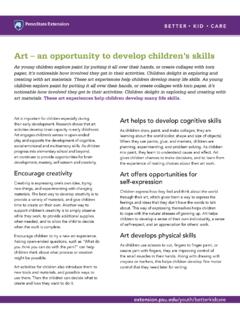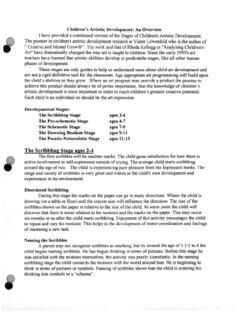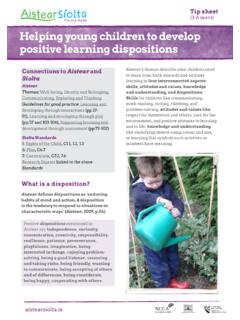Transcription of The Mathematics Educator Applying Piaget’s Theory of ...
1 The Mathematics Educator 2008, Vol. 18, No. 1, 26 30 26 Applying Piaget s Theory Applying Piaget s Theory of Cognitive Development to Mathematics Instruction Bobby Ojose This paper is based on a presentation given at National Council of Teachers of Mathematics (NCTM) in 2005 in Anaheim, California. It explicates the developmental stages of the child as posited by Piaget. The author then ties each of the stages to developmentally appropriate Mathematics instruction. The implications in terms of not imposing unfamiliar ideas on the child and importance of peer interaction are highlighted. Introduction Jean Piaget s work on children s cognitive development, specifically with quantitative concepts, has garnered much attention within the field of education.
2 Piaget explored children s cognitive development to study his primary interest in genetic epistemology. Upon completion of his doctorate, he became intrigued with the processes by which children achieved their answers; he used conversation as a means to probe children s thinking based on experimental procedures used in psychiatric questioning. One contribution of Piagetian Theory concerns the developmental stages of children s cognition. His work on children s quantitative development has provided Mathematics educators with crucial insights into how children learn mathematical concepts and ideas. This article describes stages of cognitive development with an emphasis on their importance to mathematical development and provides suggestions for planning Mathematics instruction.
3 The approach of this article will be to provide a brief discussion of Piaget s underlying assumptions regarding the stages of development. Each stage will be described and characterized, highlighting the stage-appropriate Mathematics techniques that help lay a solid foundation for future Mathematics learning. The conclusion will incorporate general implications of the knowledge of stages of development for Mathematics instruction. Underlying Assumptions Piaget believed that the development of a child occurs through a continuous transformation of thought processes. A developmental stage consists of a period of months or years when certain development takes place.
4 Although students are usually grouped by chronological age, their development levels may differ significantly (Weinert & Helmke, 1998), as well as the rate at which individual children pass through each stage. This difference may depend on maturity, experience, culture, and the ability of the child (Papila & Olds, 1996). According to Berk (1997), Piaget believed that children develop steadily and gradually throughout the varying stages and that the experiences in one stage form the foundations for movement to the next. All people pass through each stage before starting the next one; no one skips any stage.
5 This implies older children , and even adults, who have not passed through later stages process information in ways that are characteristic of young children at the same developmental stage (Eggen & Kauchak, 2000). Stages of Cognitive Development Piaget has identified four primary stages of development: sensorimotor, preoperational, concrete operational, and formal operational. Sensorimotor Stage In the sensorimotor stage, an infant s mental and cognitive attributes develop from birth until the appearance of language. This stage is characterized by the progressive acquisition of object permanence in which the child becomes able to find objects after they have been displaced, even if the objects have been taken out of his field of vision.
6 For example, Piaget s experiments at this stage include hiding an object under a pillow to see if the baby finds the object.. Dr. Bobby Ojose is an Assistant Professor at the University of Redlands, California. He teaches Mathematics education and quantitative research methods classes. His research interests encompass constructivism in teaching and learning Mathematics . Bobby Ojose 27 An additional characteristic of children at this stage is their ability to link numbers to objects (Piaget, 1977) ( , one dog, two cats, three pigs, four hippos). To develop the mathematical capability of a child in this stage, the child s ability might be enhanced if he is allowed ample opportunity to act on the environment in unrestricted (but safe) ways in order to start building concepts (Martin, 2000).
7 Evidence suggests that children at the sensorimotor stage have some understanding of the concepts of numbers and counting (Fuson, 1988). Educators of children in this stage of development should lay a solid mathematical foundation by providing activities that incorporate counting and thus enhance children s conceptual development of number. For example, teachers and parents can help children count their fingers, toys, and candies. Questions such as Who has more? or Are there enough? could be a part of the daily lives of children as young as two or three years of age. Another activity that could enhance the mathematical development of children at this stage connects Mathematics and literature.
8 There is a plethora of children s books that embed mathematical content. (See Appendix A for a non-exhaustive list of children s books incorporating mathematical concepts and ideas.) A recommendation would be that these books include pictorial illustrations. Because children at this stage can link numbers to objects, learners can benefit from seeing pictures of objects and their respective numbers simultaneously. Along with the mathematical benefits, children s books can contribute to the development of their reading skills and comprehension. Preoperational Stage The characteristics of this stage include an increase in language ability (with over-generalizations), symbolic thought, egocentric perspective, and limited logic.
9 In this second stage, children should engage with problem-solving tasks that incorporate available materials such as blocks, sand, and water. While the child is working with a problem, the teacher should elicit conversation from the child. The verbalization of the child, as well as his actions on the materials, gives a basis that permits the teacher to infer the mechanisms of the child s thought processes. There is lack of logic associated with this stage of development; rational thought makes little appearance. The child links together unrelated events, sees objects as possessing life, does not understand point-of-view, and cannot reverse operations.
10 For example, a child at this stage who understands that adding four to five yields nine cannot yet perform the reverse operation of taking four from nine. children s perceptions in this stage of development are generally restricted to one aspect or dimension of an object at the expense of the other aspects. For example, Piaget tested the concept of conservation by pouring the same amount of liquid into two similar containers. When the liquid from one container is poured into a third, wider container, the level is lower and the child thinks there is less liquid in the third container. Thus the child is using one dimension, height, as the basis for his judgment of another dimension, volume.
















